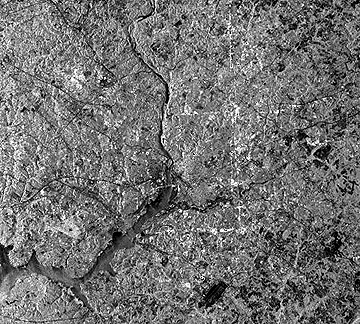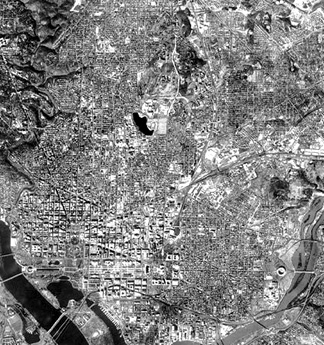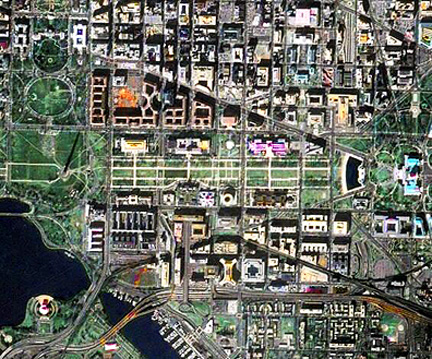The effects of that storm are evidenced by the light blue tones
in the Potomac River, resulting from a heavy silt load introduced
by runoff from the rainfall upstream. The Chesapeake Bay to the
east is, of course, unaffected by this increase in sediment. The
inner city areas of both Baltimore and Washington are easily singled
out by the blue tones that bespeak of numerous larger buildings
and a limited number of trees. More than 5 million people live
in this urban region but much of the population dwells in residential
areas in which tree-dotted landscapes remain (recent surveys have
identified the Washington area, in particular, as the most heavily
forested urban locale in the eastern U.S.). A large blotch of
deep red (abundance of trees) in the northeast part of the Washington
suburbs represents the largely undeveloped tract of land comprising
the Beltsville Agricultural Experiment Station operated by the
U.S. Department of Agriculture. Interstate 95 - the heaviest traveled
major road in the East - between Washington and Baltimore stands
out in contrast to its vegetated edges. Highway 50 past Annapolis,
the capital of Maryland, can also be seen and, if you look closely,
the high Bay Bridge over the Chesapeake narrows is just visible.
We will use a SIR-C L-band radar image obtained on April 18, 1994 from the Space Shuttle to take a closer look at the metropolitan area surrounding the U.S. capital.
 To orient you: north is to the upper right. No distinct tonal
patterns marking the more densely populated and built-up sections
of the area are evident but many of the major roads leading in
and out appear as thin dark lines. Two dark patches coincide with
the National Airport and Andrews Air Force base (lower right).
Farmlands (diminishing as outlying areas develop) make up many
of the other darker patterns. Most of these are found to the east
in the Coastal Plains. Its precise juncture (at the Fall Line)
with the hilly Piedmont (see map on page 6-1 and following text)
to the west is obscure but the Piedmont itself can be inferred
by the suggestion of more rolling terrain on the left side of
the image. A remarkable feature of this image is the three light-toned
lines forming part of a square. This coincides with the actual
boundaries of the District of Columbia and Maryland to the outside.
Staff at the Jet Propulsion Laboratory (SIR-C's operators) have
interpreted this tonal phenomenon as expressing strong reflections
from building corners that line avenues along the boundaries.
But, this writer (NMS, who lived in the area for 21 years) is
skeptical of the explanation because he has not observed any unusual
concentration of large buildings exclusive to the streets along
the boundaries, (along the NE-SW edge many are residences no different
than other homes away from the boundary streets). The line next
to the boundary running NW-SE (right side of square) that continues
beyond the District is a power line.
To orient you: north is to the upper right. No distinct tonal
patterns marking the more densely populated and built-up sections
of the area are evident but many of the major roads leading in
and out appear as thin dark lines. Two dark patches coincide with
the National Airport and Andrews Air Force base (lower right).
Farmlands (diminishing as outlying areas develop) make up many
of the other darker patterns. Most of these are found to the east
in the Coastal Plains. Its precise juncture (at the Fall Line)
with the hilly Piedmont (see map on page 6-1 and following text)
to the west is obscure but the Piedmont itself can be inferred
by the suggestion of more rolling terrain on the left side of
the image. A remarkable feature of this image is the three light-toned
lines forming part of a square. This coincides with the actual
boundaries of the District of Columbia and Maryland to the outside.
Staff at the Jet Propulsion Laboratory (SIR-C's operators) have
interpreted this tonal phenomenon as expressing strong reflections
from building corners that line avenues along the boundaries.
But, this writer (NMS, who lived in the area for 21 years) is
skeptical of the explanation because he has not observed any unusual
concentration of large buildings exclusive to the streets along
the boundaries, (along the NE-SW edge many are residences no different
than other homes away from the boundary streets). The line next
to the boundary running NW-SE (right side of square) that continues
beyond the District is a power line.
Much more detail is presented in the next two SPOT images. The false color version at the top (about 24 km [15 miles] on a side) is made by the HRV multispectral sensor that provides 20 meter resolution. On the bottom is a 10 meter panchromatic image that extends about 13 km (8 miles) on a side, showing the central city and its many federal buildings.

The HRV image just about encompasses the Capitol Beltway which rings the Washington area but does not stand out here. Several vegetated areas are worth identifying: the wooded area known as Rock Creek Park; Roosevelt Island in the Potomac; the Arlington National Cemetary; the National Arboretum. The circular Robert F. Kennedy (RFK) stadium is easily picked out. (Check an atlas to locate these features.)
The centerpoint in this and the next two images is the Mall that runs from the Lincoln Memorial (4) eastward to the U.S. Capitol building (3). These two buildings (see below), along with the Kennedy Center for the Performing Arts (5), are symbolic of the graceful white marble edifices that make up the many government offices, monuments, and cultural centers in what many believe to be one of the most beautiful capital cities in the world.
A "birds-eye" view of this central area is afforded by this aerial oblique color photograph taken from the Virginia side of the Potomac.
Those viewers who have visited the capital city before should recognize many of the landmarks. On the lower right is the Pentagon and part of the National Cemetary is in the foreground. Beyond Roosevelt Island is the Kennedy Center. Nearby are the Lincoln Memorial and, on the Tidal Basin, the Jefferson Memorial. The White House is hidden by trees but the Ellipse (a near-circular drive and parkland) is just to its south. The Washington Monument is too thin to be seen clearly in this photo. But, many government office buildings lining the mall are evident.
The panchromatic SPOT image seen above shows the layout of buildings around the Mall and the downtown business area as well as homes (many are joined row houses) in the District. Again, consult a map to confirm the location of most of the well-known individual edifices. To orient yourself, pick out major streetways such as Independence, Constitution, Pennsylvania, New York, and Massachusetts Avenues, and the Interstate 395 extension.
We offer you an identification challenge in this last image of Washington, D.C. It is constructed from the merge of a Landsat TM subscene rendered in the IHS (Intensity; Hue; Saturation) color system and a 2-meter (6.6 feet) resolution space photo made by cosmonauts using the Kosmos KVR-1000 camera onboard the Russian Mir space station.

Use a map to locate the following: Washington Monument; Jefferson Memorial; U.S. Capitol Building; Union Station; National Air and Space Museum; Hirschorn Gallery; National Gallery of Art; National Museum of Natural History; Smithsonian Administration Building; Federal Bureau of Investigation (FBI); The White House; U.S. Dept. of State; U.S. Dept. of the Treasury. What important monument is out of the picture? Also, don't look for the NASA building if you have an older map- its headquarters has moved and most atlases don't show this new location.
Code 935, Goddard Space Flight Center, NASA
Written by: Nicholas M. Short, Sr. email: nmshort@epix.net
and
Jon Robinson email: Jon.W.Robinson.1@gsfc.nasa.gov
Webmaster: Bill Dickinson Jr. email: rstwebmaster@gsti.com
Web Production: Christiane Robinson, Terri Ho and Nannette Fekete
Updated: 1999.03.15.